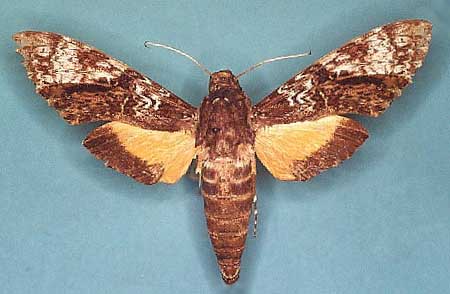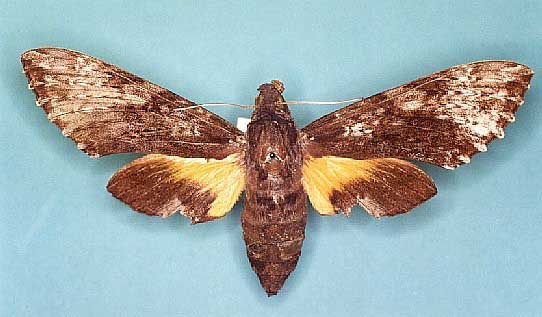Isognathus rimosa papayae
(Boisduval [1875])

Isognathus rimosa papayae male
This site has been created by
Bill Oehlke at oehlkew@islandtelecom.com
Comments, suggestions and/or additional information are welcomed by Bill.
TAXONOMY:
Family: Sphingidae, Latreille, 1802
Subfamily: Macroglossinae, Harris, 1839
Tribe: Dilophonotini, Burmeister, 1878
Genus: Isognathus G. Felder & R. Felder, 1862 ...........
Species: rimosus papayae (Boisduval, [1875])
|
MIDI MUSIC
.....It's a Wonderful World.....
copyright C. Odenkirk
ON.OFF
<bgsound src="world.mid" LOOP=FOREVER>
|
DISTRIBUTION:
Isognathus rimosa papayae
(Wing span: , females larger than males),
flies in
French Guiana: Cayenne, the specimen type locality (this locality may be in question; more likely Colombia; CATE)
and in
Venezuela; and
Colombia.
The forewing is strongly marked with brown over white.
The hindwing black marginal border is slightly narrower than in Isognathus rimosa inclitus.
The hindwing underside has a second postmedian line that is very prominent at the costal margin, with the antemedian line generally absent. CATE
Isognathus rimosa inclitus Edwards, 1887, flies in Mexico: Orizaba.
Isognathus rimosa jamaicensis Rothschild & Jordan, 1915, flies in Jamaica.
Isognathus rimosa molitor Rothschild & Jordan, 1915, flies in ??
Isognathus rimosa wolcotti Clark, 1922, flies in Peurto Rico: Rio Piedras.
The nominate subspecies flies in Mexico; Belize; Guatemala; probably through Central America to at least Costa Rica; Cuba: Santiago del Cuba; Holguin; Venezuela;
and possibly in northern Brazil.
FLIGHT TIMES:
There are probably several flights
throughout the year.
ECLOSION:
Moths emerge from pupae in thin-walled cocoons
under leaf litter within 8-24 days of pupation.
SCENTING AND MATING:
Females call in the males with a pheromone released from a gland at the tip of
the abdomen. Adults nectar at flowers, including petunia.

Isognathus rimosus papayae female
EGGS, LARVAE, PUPAE:
Females probably lay eggs on leaves of Apocynacea.
Larvae have
long tails; colouration suggests they are unpalatable to birds.
The pupae are also quite colourful, and, I suspect,
are very lively. Moths generaly emerge witin 8-24 days of pupation.
Return to Sphingidae Index
Return to Dilophonotini Tribe

